 | |
| Abbreviation | MAV |
|---|---|
| Formation | 1879 |
| Type | Legislated peak body |
| Headquarters | Melbourne, Australia |
President | Coral Ross [1] |
| Website | www |
The Municipal Association of Victoria (MAV) is the legislated peak body for representing local governments in Victoria.
 | |
| Abbreviation | MAV |
|---|---|
| Formation | 1879 |
| Type | Legislated peak body |
| Headquarters | Melbourne, Australia |
President | Coral Ross [1] |
| Website | www |
The Municipal Association of Victoria (MAV) is the legislated peak body for representing local governments in Victoria.
The overall purpose of the MAV is to represent the interests of the 79 local governments in Victoria. Its stated roles are to support councils and councillors, provide a platform for advocacy, and promote the role of local government. The organisation also provides services to its member councils. These services include joint procurement, insurance, and policy advice. [2]
The Association was created in 1879 to represent the interests of local governments in Victoria. The Municipal Association Act 1907 of the Parliament of Victoria formally recognised the organisation as a peak body, primarily for the purpose of creating the Municipal Officers Fidelity Guarantee Fund. [3]
During the amalgamation of local councils in Victoria in the early 1990s, the MAV campaigned against the compulsory competitive tendering introduced for the 78 new councils created after the process, arguing that it had significant impacts on both council employees and residents. [4] [5]
Following the amalgamations and return of democratic government in 1996/97, the MAV ran a number of programs to monitor and support councils restructuring in the new process. This included the Step Asset Management Program, which eventually assessed a large number of primarily rural councils as being financially unsustainable. [6]
In February 2015, the Victorian Auditor-General published a report into Local Government Victoria and the MAV on the effectiveness, efficiency and economy of the support provided to councils. It found serious structural and governance deficiencies in the MAV, prompting significant media coverage on its findings. [7] [8] The report questioned many aspects of the organisation's operations, including value for money of its procurement activities and lack of public accountability. [9] The report's conclusions prompted Frankston City Council to leave the MAV in August 2015. [10] It rejoined in August 2017 after a new council resolution was passed. Many other councils expressed similar concerns and considered ceasing their memberships, including the City of Monash, [11] the Shire of Mitchell, [8] and the City of Boroondara. [12] Councillors from the cities of Yarra and Melbourne also expressed concerns over the report. [13] Boroondara later withdrew its representation from the Association after a lengthy and public court battle with the City of Darebin, citing issues presented in the Auditor-General's report. [14] [15]
The MAV's initial response to the report disputed some of its key conclusions, including the premise that the MAV could be subject to the direction of the state government. [16] However, following the appointment of a new board in March 2015 and a motion from the State Council in early 2016, independent auditors and consultants through Ernst & Young and Deloitte have been appointed to oversee the implementation of the report's recommendations. [17]
The Board of the MAV is made up of councillors from its members’ councils. It consists of 12 members elected by councils in each region and a directly elected president. Elections are conducted once every two years. [18]
The State Council operates as the governing body of the Association. It is made up of single representatives from all member councils who formulate, debate, and vote on the operations of the MAV. This includes association rules, policies, and strategic planning. [19]
All Victorian local governments are members of the MAV. The City of Frankston withdrew in 2015 but rejoined in August 2017 after a new council resolution was passed. [10] [20] The City of Boroondara resolved to withdraw its representation to the Association in December 2016, preventing Cr Coral Ross from contesting the presidency of the MAV. [21] [22] Cr Ross was later elected president of the MAV in 2019. [23]
|
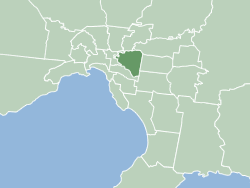
The City of Boroondara is a local government area in Victoria, Australia. It is located in the eastern suburbs of Melbourne. It was formed in June 1994 from the amalgamation of the Cities of Kew, Camberwell and Hawthorn.

The City of Whittlesea is a local government area located in the outer northern suburbs of Melbourne, the state capital of Victoria, Australia. The city covers an area of 490 square kilometres (189.2 sq mi), and in June 2018, it had a population of 223,322.

The City of Darebin is a local government area in Victoria, Australia, in the northern suburbs of Melbourne. It has an area of 54 square kilometres (20.8 sq mi) and in June 2018 Darebin had a population of 161,609. Municipal offices are located at 350 High Street, Preston.
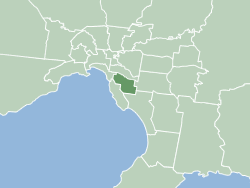
The City of Glen Eira is a local government area in Victoria, Australia. It is located in the south-eastern suburbs of Melbourne. It has an area of 39 square kilometres (15.06 sq mi) and has an estimated population of 153,858.
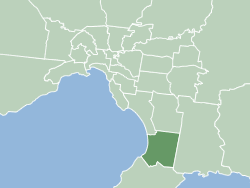
The City of Frankston is a local government area (LGA) in Victoria, Australia in the southern suburbs of Melbourne. It has an area of 130 square kilometres, and in June 2018, the City of Frankston recorded a population of 141,845.

The City of Banyule is a local government area in Victoria, Australia in the north-eastern suburbs of Melbourne. It was created under the Local Government Act 1989 and established in 1994 as an amalgamation of former councils. It has an area of 63 square kilometres (24.3 sq mi) and lies between 7 and 21 km from central Melbourne. In 1994 it had a population of 116,000. In June 2018 Banyule had a population of 130,237. The Yarra River runs along the City's southern border while its western border is defined by Darebin Creek.

The City of Brimbank is a local government area located within the metropolitan area of Melbourne, Victoria, Australia. It comprises the western suburbs between 10 and 20 km west and northwest from the Melbourne city centre.
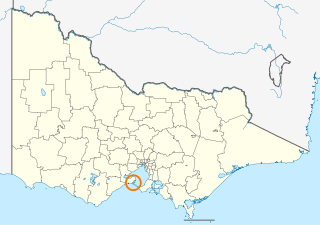
The Borough of Queenscliffe is a local government area in the Barwon South West region of Victoria, Australia, located in the southern part of the state. It is the smallest local government area in Victoria, covering an area of 10.83 square kilometres (4.18 sq mi) and, in June 2018, had a population of 2,982. It includes only two settlements, which are Queenscliff and Point Lonsdale. It is situated on the south coast, south-east of Geelong on the Bellarine Peninsula south of Swan Bay and next to the Port Phillip Heads, the entrance to Port Phillip Bay from Bass Strait.
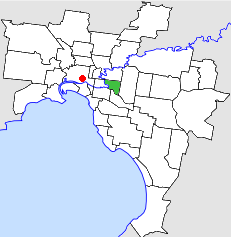
The City of Hawthorn was a local government area about 4 kilometres (2.5 mi) east of Melbourne, the state capital of Victoria, Australia, on the southeast bank of the Yarra River. The city covered an area of 9.71 square kilometres (3.75 sq mi), and existed from 1860 until 1994.
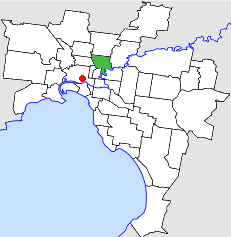
The City of Northcote was a local government area about 5 kilometres (3 mi) northeast of Melbourne, the state capital of Victoria, Australia. The city covered an area of 17.62 square kilometres (6.80 sq mi), and existed from 1883 until 1994.

The Shire of Mornington was a local government area about 50 kilometres (30 mi) south of Melbourne, the state capital of Victoria, Australia, encompassing the western extremity of the Mornington Peninsula. The shire covered an area of 90.65 square kilometres (35.0 sq mi) immediately to the south of Frankston, and existed from 1860 until 1994.

The City of Frankston was a local government area about 40 kilometres (25 mi) south of Melbourne, the state capital of Victoria, Australia. The city covered an area of 70.96 square kilometres (27.4 sq mi) in and around Frankston, and existed from 1860 until 1994.

The City of Preston was a local government area about 11 kilometres (7 mi) north-northeast of Melbourne, the state capital of Victoria, Australia. The city covered an area of 37.05 square kilometres (14.31 sq mi), and existed from 1871 until 1994.
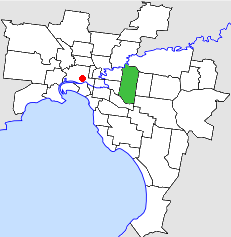
The City of Camberwell was a local government area about 10 kilometres (6 mi) east of Melbourne, the state capital of Victoria, Australia. The city covered an area of 36.01 square kilometres (13.90 sq mi), and existed from 1914 until 1994.

Bike paths around Melbourne have been developed over many decades. Many off-road trails follow current or former watercourses and traverse long distances, so that responsibility for planning and maintenance is split between various State Government authorities and local councils. With the increased recognition from all levels of government of the benefits of cycling, Melbourne today has a network of shared bicycle trails which have developed over time along its river and creek systems and alongside freeways and railways.

Local government in the Australian state of Victoria consists of 79 local government areas (LGAs). Also referred to as municipalities, Victorian LGAs are classified as cities (34), shires (38), rural cities (6) and boroughs (1). In general, an urban or suburban LGA is called a city and is governed by a City Council, while a rural LGA covering a larger rural area is usually called a shire and is governed by a Shire Council. Local councils have the same administrative functions and similar political structures, regardless of their classification.

The 2024 Victorian local elections will be held in October 2024 to elect the councils of the 79 local government areas in Victoria.
This is a list of local government area results for the 2020 Victorian local elections.

The 2002 Victorian local elections were held on 16 March 2002 to elect the councils of 17 of the 78 local government areas in Victoria, Australia.